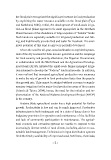Page 668 - 2015-37
P. 668
the lood plain recognized the signiicant increase in food production
by exploiting the water resource available on the lood plain (Faye
and Sutheland, 2006). Initial, the development of small-scale irriga-
tion on lood plains appears to be most appropriate in the Northern
States because of the abundance of large expanse of “fadama” lands.
Such lands are especially suitable for irrigated production and ish-
ing, and traditionally provide feed and water for livestock. The enor-
mous potential of this land is only very partially developed.
Given the need for all-year-round cultivation to exploit the poten-
tials of the dry seasons for farm income generation and the campaign
for food security and poverty alleviation, the Nigerian Government,
in collaboration with the World Bank and the Agricultural Develop-
ment Bank (ADB), initiated the small-scale farmer-managed irriga-
tion schemes to develop the “Fadama” lands nationwide. In addition,
it was realized that increased agricultural production was necessary
to make the rate of growth in food production faster than the popula-
tion growth rate. This cannot be attained without recourse to supple-
mentary irrigation for the major food production areas of the country
(Adeolu & Taiwo, 2004), hence, the need for the initiation and im-
plementation of the National Fadama development Project (NFDP)
in the country.
Katsina State agricultural sector has a high potential for further
growth. Productivity is low and can be much improved. Productive
infrastructure is both inadequate and in a state of decay due to low
budgetary provision for operation and maintenance of the facilities
and lack of community participation in maintenance. The agricul-
tural research and extension systems are unable to respond to the
increasingly diverse needs of rural clients, including advice on sus-
tainable land management. Deiciencies in input distribution systems
limit the timely availability of improved seed, fertilizers, chemicals,
-3-

